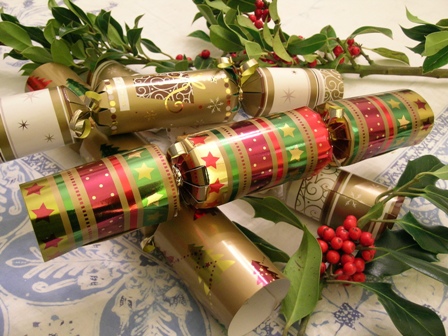History Of Christmas Crackers!
 |
Christmas crackers or bon-bons are an integral part of Christmas celebrations in the United Kingdom and Commonwealth countries such as Australia, Canada, New Zealand and South Africa. They are also popular in Ireland. A cracker consists of a cardboard tube wrapped in a brightly decorated twist of paper, making it resemble an oversized sweet-wrapper. The cracker is pulled by two people, and, much in the manner of a wishbone, the cracker splits unevenly. The split is accompanied by a small bang or snapping sound produced by the effect of friction on a chemically impregnated card strip (similar to that used in a cap gun).
Crackers are typically pulled at the Christmas dinner table or at parties. In one version of the cracker tradition, the person with the larger portion of cracker empties the contents from the tube and keeps them. In another each person will have their own cracker and will keep its contents regardless of whose end they were in. Typically these contents are a coloured paper hat or crown; a small toy, small plastic model or other trinket and a motto, a joke or piece of trivia on a small strip of paper.
 |
Assembled crackers are typically sold in boxes of three to twelve. These typically have different designs usually with red, green and gold colors. Making crackers from scratch using the tubes from used toilet rolls and tissue paper is a common Commonwealth activity for children. Kits to make crackers can also be purchased.
Crackers are also a part of New Year celebrations in Russia (where they are called хлопушка - khlopushka) and some countries of the former Soviet Union. Those are however more similar to pyrotechnical devices, normally used outdoors, activated by one person, and produce a stronger bang accompanied by fire and smoke.
History
The Oxford English Dictionary records the use of cracker bonbons and the pulling of crackers from the early 1840s. Tradition tells of how Thomas J. Smith of London invented crackers in 1847. He created the crackers as a development of his bon-bon sweets, which he sold in a twist of paper (the origins of the traditional sweet-wrapper). As sales of bon-bons slumped, Smith began to come up with new promotional ideas. His first tactic was to insert mottos into the wrappers of the sweets ( fortune cookies), but this had only limited success.Smith added the "crackle" element when he heard the crackle of a log he had just put on a fire. The size of the paper wrapper had to be increased to incorporate the banger mechanism, and the sweet itself was eventually dropped, to be replaced by a small gift. The new product was initially marketed as the Cosaque (i.e., Cossack), but the onomatopoeic "cracker" soon became the commonly used name, as rival varieties came on the market. The other elements of the modern cracker, the gifts, paper hats and varied designs, were all introduced by Tom Smith's son, Walter Smith, to differentiate his product from the rival cracker manufacturers which had suddenly sprung up.
 |
However, the OED may well be in error as they appear to have been available in France in 1817. Lt. Colonel Felton Hervey states in a letter dated 7 November 1817 The night before last Arthur Hill desired me to give a letter to the Duchess of R[ichmon]d, which I did very innocently. It contained one of these crackers, called Cossacks, which are sold in the fair here. It went off, and the duchess also, into one of the most violent fits of laughing hysterics ever witnessed. I am happy to say she does not think me guilty. I wonder it did not kill the old woman.
A Little Video on How To Make Christmas Crackers

Comments
Post a Comment